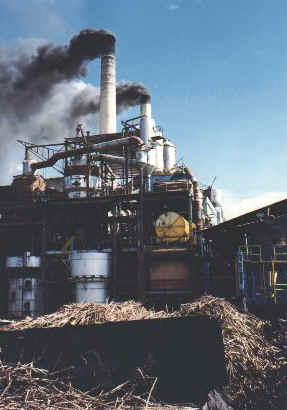 Santa Clara mill
Santa Clara mill Santa Clara mill
Santa Clara mill
Mexico has one of the world's highest rates of sugar consumption per capita, and the country was traditionally a net exporter of sugar. Despite a lack of capital investment in the mills under state ownership, and the relative undercapitalization of the growers in the ejido sector, the cane land around Los Reyes is ideal for the crop and sucrose yields are excellent by national standards. The availability of an abundance of water for irrigation and the processing of cane into sugar in the mills is an additional advantage. Despite this, and the low wages paid to cane cutters, even after the new owners had made modest investments in the mills, they were not able to compete against cheaper imports from countries such as the Philippines. US sugar producers, in contrast, were given a substantial measure of protection against Mexican competition as the Clinton administration offered additional inducements to the farm lobby to secure congressional approval for the NAFTA.
The three million tons of foreign sugar imported in 1991 and 1992 left the mill owners with such large unsold stocks that they were forced to borrow heavily to maintain operations, and it has proved impossible to liquidate this debt since they have faced additional problems from unfair competition. The United States is a major world producer of the corn syrup that is widely used as a substitute for sugar in soft drinks and various sweet foods. Mexican sugar producers have accused the United States of dumping corn syrup on the Mexican market at prices 30% below its real value. By the end of 1997, the closure of a further twenty sugar mills and major new job losses amongst the two and a half million people dependent on the industry were being predicted.
The mills have provided employment for the sons of ejidatarios as well as for people without land rights, and even some people with land have chosen to work in the mills as well. The industry has remained the hub of the local urban economy. Declining grower and worker incomes had an immediate impact on local business, despite the existence of other commercial agricultural sectors, in particular avocado cultivation, and the fact that Los Reyes and the surrounding communities also have a substantial migrant population living and working in the United States.
The videos on this page illustrate some different aspects of the processing of sugar cane, which results not simply in the production of sugar, but also of alcohol. Even the waste products of the recycled for use as fuel. Sidney Mintz has argued that the sugar mill was the historical prototype of the capitalist factory, introducing modern labour disciplines and organization long before the "industrial revolution" in the British textile industry. Even the relatively antiquated ingenios of Santa Clara and San Sebastian illustrate the complexities of the industrial processes involved in the production of sugar, which in this case is sold to consumers without the additional stage of refining.
For a region like Los Reyes, these "factories in the fields" have provided a livelihood for a range of local people of a kind that is not available in a region such as the Ciénega de Chapala without migration to more distant places. Although many people from Los Reyes also migrate, and the children of relatively prosperous ejidatario families as well as poorer landless ones often work full-time in the United States, returning only for holidays, the social implications of a complete collapse of the industry would be incalculable.
![]() Unloading cane at San Sebastian mill
Unloading cane at San Sebastian mill
![]() Santa Clara Mill. The cane is repeatedly crushed by rollers and drenched with water to separate the outer husk from the sucrose (jugo mezclado), which is then treated with lime in a tank, clarified, and passed through evaporation tanks and boiled to produce cane syrup and molasses.
Santa Clara Mill. The cane is repeatedly crushed by rollers and drenched with water to separate the outer husk from the sucrose (jugo mezclado), which is then treated with lime in a tank, clarified, and passed through evaporation tanks and boiled to produce cane syrup and molasses.
![]() Santa Clara Mill. Regulating the furnaces and sugar evaporators.
Santa Clara Mill. Regulating the furnaces and sugar evaporators.
![]() Santa Clara Mill. Working on the centrifuges producing the unrefined sugar which the mills sell as a commercial product to consumers.
Santa Clara Mill. Working on the centrifuges producing the unrefined sugar which the mills sell as a commercial product to consumers.